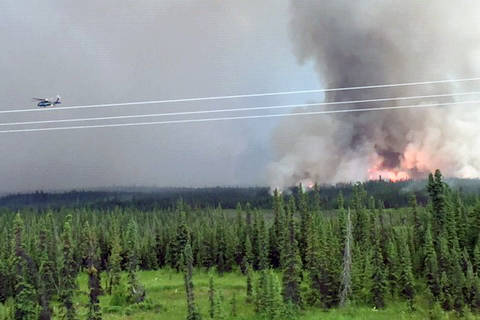After enjoying three years of relatively quiet summer wildfire seasons, Alaska was overdue for a big one. As most by now are keenly aware, 2019 more than filled the bill.
In a typical fire season, Alaska has about 500 fires that burn about 650,000 acres. But as of Aug. 7, a total of 614 fires had burned approximately 2.4 million acres across Alaska — and the fire season isn’t over yet. While much of Interior and Southwest Alaska have received substantial rain recently, relatively rainless Southcentral Alaska remains dry with high fire danger. Even with the rain, 232 fires are still actively burning, and some won’t stop until the snow flies.
The season kicked off to a fast start on April 30, when a warm, early spring helped ignite the Oregon Lakes fire, southeast of Delta Junction. As the summer progressed, many areas experienced high, even record-high, temperatures. Several days of heavy lighting strikes in late June brought several double-digit increases in the total daily fire count.
Facing many fires posing significant threats to Alaska lives, property and infrastructure, the Division of Forestry quickly put all Alaska’s fire crews to work. We then brought in thousands of firefighters from the Lower 48 and Canada, as well as multiple incident management teams to help suppress and manage the larger project fires. Much like fire departments have “mutual aid” agreements, wildland firefighters in other jurisdictions will respond when called, sharing the workload and the risks.
To date, 110 crews from the Lower 48, and personnel from 46 states, Puerto Rico and several Canadian provinces fought wildfires in Alaska this summer. They brought multiple air tankers, water-scooping aircraft and helicopters, which bolstered our initial attack capabilities and provided vital logistical support.
For all this assistance, the State extends an Alaska-sized “Thank-you” to all who came north to help. We also thank our State of Alaska interagency partners, the Bureau of Land Management’s Alaska Fire Service, and the U.S. Forest Service, as well as several Canadian provinces and our local fire departments and Alaska National Guard units, for their help this season.
While we lost a handful of structures to fire this season, firefighters did a commendable job protecting thousands of others in settled communities and in the wildland-urban interface from the Chalkyitsik Complex, Grouse Creek, Kobe, Malaspina, Montana Creek, Shovel Creek and Swan fires, and others. Firefighters also worked to protect rural villages, Native allotments, fish camps, gold mines, and various other infrastructure threatened by wildfires.
Finally, praise is due to the citizens of Alaska who faced the smoke, travel delays, interruptions of business or recreational activities, and sometimes even evacuation from their homes. As fire managers and firefighters, we strive to minimize such negative effects, and clearly communicate with the public about wildfires and what we’re doing about them. Crews protecting communities from wildfire sincerely welcomed the support, encouragement and thanks they received from local residents and businesses.
Another way to show support is to be ready for next time by practicing the “Firewise” principles at your home, businesses and property — for details, visit http://forestry.alaska.gov/. Going one step further, the Community Wildfire Protection Plans and landscape-level fuel-reduction projects in high-risk areas can play a key role in limiting the danger and impact of future wildland fires. Two of our most serious fires this season relied on large-scale fuel breaks, or fire lines, that gave firefighters a good defensive position to work from, and to keep fires from spreading into residential areas.
Finally, I hope you’ll join me in wishing Smoky Bear a happy seventy-fifth birthday, and taking to heart his timeless admonition: “Only YOU can prevent wildfires”!
John “Chris” Maisch has served as Alaska state forester and Director of the Alaska Division of Forestry since 2005.
John “Chris” Maisch has served as Alaska state forester and Director of the Alaska Division of Forestry since 2005.

